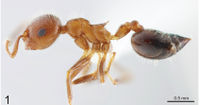Crematogaster fumikoae
| Crematogaster fumikoae | |
|---|---|

| |
| Scientific classification | |
| Kingdom: | Animalia |
| Phylum: | Arthropoda |
| Class: | Insecta |
| Order: | Hymenoptera |
| Family: | Formicidae |
| Subfamily: | Myrmicinae |
| Tribe: | Crematogastrini |
| Genus: | Crematogaster |
| Species group: | popohana |
| Species: | C. fumikoae |
| Binomial name | |
| Crematogaster fumikoae Hosoishi & Ogata, 2015 | |
Nothing is known about the biology of Crematogaster fumikoae.
Identification
Hosoishi and Ogata (2015) - A member of the Crematogaster popohana group (Crematogaster fumikoae, Crematogaster popohana, and Crematogaster popohana amia). The group can be distinguished from other Asian Crematogaster species by the slender petiole with weakly convex sides.
Crematogaster fumikoae is similar to Crematogaster popohana but can be distinguished by the propodeal spines curved upward at tips, densely sculptured mesopleuron, and acutely developed subpetiolar process (Fig. 9 - see the caste section below.).
Distribution
Distribution based on Regional Taxon Lists
Oriental Region: Thailand (type locality), Vietnam.
Distribution based on AntMaps
Distribution based on AntWeb specimens
Check data from AntWeb
Countries Occupied
| Number of countries occupied by this species based on AntWiki Regional Taxon Lists. In general, fewer countries occupied indicates a narrower range, while more countries indicates a more widespread species. |

|
Estimated Abundance
| Relative abundance based on number of AntMaps records per species (this species within the purple bar). Fewer records (to the left) indicates a less abundant/encountered species while more records (to the right) indicates more abundant/encountered species. |

|
Biology
Castes
Nomenclature
The following information is derived from Barry Bolton's Online Catalogue of the Ants of the World.
- fumikoae. Crematogaster fumikoae Hosoishi & Ogata, 2015a: 14, figs. 1-4, 9 (w.) THAILAND.
- Type-material: holotype worker, 15 paratype workers.
- Type-locality: holotype Thailand: Doi Suthep, nr Chiang Mai, 21.xii.1997 (F. Yamane); paratypes with same data.
- Type-depositories: TNHM (holotype); BMNH, CASC, FRKL, KUEC, MHNG, MZBJ, SKYC (paratypes).
- Status as species: Khachonpisitsak, et al. 2020: 90.
- Distribution: Thailand, Vietnam.
Unless otherwise noted the text for the remainder of this section is reported from the publication that includes the original description.
Description
Worker
HW 0.75; HL 0.75; CI 100; SL 0.65; SI 87; EL 0.17; PW 0.42; WL 0.88; PSL 0.13; PtL 0.26; PtW 0.21; PtH 0.19; PpL 0.15; PpW 0.20; PtHI 73; PtWI 81; PpWI 133; WI 95 (HOLOTYPE worker measured).
HW 0.62-0.82; HL 0.64-0.80; CI 96-103; SL 0.60-0.72; SI 87-97; EL 0.15-0.18; PW 0.35- 0.48; WL 0.75-0.94; PSL 0.10-0.15; PtL 0.23- 0.29; PtW 0.18-0.23; PtH 0.17-0.21; PpL 0.14- 0.17; PpW 0.18-0.22; PtHI 64-77; PtWI 67-81; PpWI 127-150; WI 90-105 (Seven paratype workers measured).
Workers with weak polymorphism.
Head appearing subquadratic; posterior corners of head rounded. Anterior clypeal margin almost straight and slightly concave medially. Compound eyes slightly projecting beyond lateral margins of head in full face view. Scape reaching posterior corner of head, with erect setae.
Anterior margin of pronotal collar weakly concave in dorsal view. Pronotal dorsum with ridges laterally. Mesonotal dorsum with lateral ridges; the ridges forming flat dorsal outline in lateral view; the ridges extending posteriorly to the metanotal groove and anterior propodeal dorsum. Pronotum not forming same dorsal outline with mesonotum in lateral view. Metanotal groove almost straight on median portion in dorsal view, not so deep, dorsolateral ridges connecting the region between the mesonotum and propodeum. In lateral view, dorsal outline of anterior portion of propodeum to propodeal spines appears straight. Propodeal spiracles elliptical and large, situated at posterolateral corners of propodeum, some distance from the metapleural gland bulla. Propodeal spines long, curved upward at tips; length greater than diameter of propodeal spiracles.
Petiole slender elliptical, median portion slightly broader. Posterior portion of petiole with ridges dorsolaterally. Subpetiolar process acutely developed anteriorly; thin lobe developed posteriorly. Postpetiole weakly bilobed with feeble longitudinal median sulcus. Petiole as wide as postpetiole in dorsal view.
Dorsal surface of head sparsely punctate, but with longitudinal rugulae on gena and surrounding antennal sockets. Clypeus striated with longitudinal rugulae; rugulae extending to posterior clypeal margin. Anterolateral margin of pronotum with rugulae. Lateral surface of pronotum weakly sculptured with feeble rugulae. The lamellate-like rugulae not covering metanotal groove dorsolaterally. Mesopleuron densely sculptured. Dorsal surface of propodeum generally smooth, but striated with rugulae dorsolaterally. Lateral surface of propodeum generally smooth and shiny. Lateral sides of petiole weakly punctate. Dorsal surface of postpetiole weakly punctate.
Standing pilosity sparse. Dorsum of head with abundant erect setae. Clypeus with two pairs of long setae on anterior portion; one pair of setae directed upwards and one pair directed downwards. Anterior clypeal margin with longer setae on median portion, and shorter setae on sides. Mesosoma with sparse erect setae. Petiole and postpetiole with sparse erect to suberect setae. Fourth abdominal tergite with sparse erect setae.
Body color reddish-brown except for dark brown gaster.
Type Material
Holotype worker from THAILAND: Doi Suthep, nr Chiang Mai, 21.xii.1997 (F. Yamane) (Natural History Museum of the National Science Museum). Fifteen paratype workers, same data as holotype (The Natural History Museum, California Academy of Sciences, Forest Research Institute Malaysia, Kepong, Kyushu University Collection, Musee d'Histoire Naturelle Genève, Bogor Zoological Museum, SKY Collection)
Etymology
This species is dedicated to Ms. Fumiko Yamane, who collected the type material.
Determination Clarifications
This species corresponds to Crematogaster sp. 76 of SKY (Eguchi et al. 2005).
References
- Hosoishi, S. and Ogata, K. 2015. Review of the Crematogaster popohana-group with the description of a new species from the Indochinese Peninsula (Hymenoptera: Formicidae). Asian Myrmecology. 7:11-18.
- Khachonpisitsak, S., Yamane, S., Sriwichai, P., Jaitrong, W. 2020. An updated checklist of the ants of Thailand (Hymenoptera, Formicidae). ZooKeys 998, 1–182 (doi:10.3897/zookeys.998.54902).
References based on Global Ant Biodiversity Informatics
- Hosoichi S., and K. Ogata. 2015. Review of the Crematogaster popohana-group with the description of a new species from the Indochinese Peninsula (Hymenoptera: Formicidae). Asian Myrmecology 7: .


